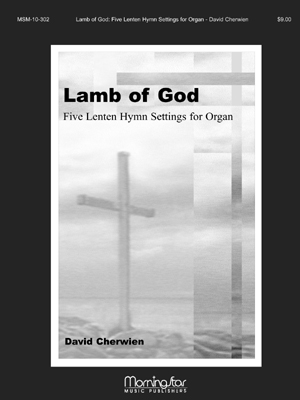- |
User Links
Agnus Dei
O Lamb of God, our Savior
Author: Nicolaus Decius; Translator: Johann Christian JacobiTune: O LAMM GOTTES, UNSCHULDIG
Published in 6 hymnals
Audio files: MIDI
Representative Text
1 O Lamb of God our Saviour!
Kill'd on the Tree of Sorrow!
Thy suff'ring meek Behaviour
Paid what thou didst not borrow.
Thy bearing our Transgression
Secur'd us from Damnation.
Have Mercy upon us, O Jesu! O Jesu!
2 O Lamb of God our Saviour,
Kill'd on the Tree of Sorrow!
Thy suff'ring meek Behaviour
Paid what thou didst not borrow.
Thy bearing our Transgression
Secur'd us from Damnation.
Acknowledge thou us, O Jesu! O Jesu!
3 O Lamb of God, our Saviour,
Kill'd on the Tree of Sorrow!
Thy suff'ring meek Behaviour
Paid what thou didst not borrow.
Thy bearing our Transgression
Secur'd us from Damnation.
O grant us thy Peace, O Jesu! O Jesu!
Source: The Christians Duty, exhibited, in a series of Hymns: collected from various authors, designed for the worship of God, and for the edification of Christians (1st Ed.) #CCXXI
Author: Nicolaus Decius
Decius, Nicolaus (Nicolaus a Curia or von Hofe, otherwise Hovesch, seems to have been a native of Hof, in Upper Franconia, Bavaria, and to have been originally called Tech. He became a monk, and was in 1519 Probst of the cloister at Steterburg, near Wolfenbüttel. Becoming favourable to the opinions of Luther, he left Steterburg in July, 1522, and went to Brunswick, where he was appointed a master in the St. Katherine and Egidien School. In 1523 he was invited by the burgesses of Stettin to labour there as an Evangelical preacher along with Paulus von Rhode. He became preacher at the Church of St. Nicholas; was probably instituted by the Town Council in 1526, when von Rhode was instituted to St. Jacob's; and at the visitation in 1535 was re… Go to person page >Translator: Johann Christian Jacobi
Jacobi, John Christian, a native of Germany, was born in 1670, and appointed Keeper of the Royal German Chapel, St. James's Palace, London, about 1708. He held that post for 42 years, and died Dec. 14, 1750. He was buried in the Church of St. Paul's, Covent Garden. His publications included :— (1) A Collection of Divine Hymns, Translated from the High Dutch. Together with their Proper Tunes and Thorough Bass. London: Printed and Sold by J. Young, in St. Paul’s Churchyard; . . . 1720. This edition contains 15 hymns. Two years later this collection, with a few changes in the text and much enlarged, was republished as (2) Psalmodia Germanica; or a Specimen of Divine Hymns. Translated from the High Dutch. Together with their Proper Tunes… Go to person page >Text Information
| First Line: | O Lamb of God, our Savior |
| Title: | Agnus Dei |
| German Title: | O Lamm Gottes unschuldig |
| Author: | Nicolaus Decius |
| Translator: | Johann Christian Jacobi |
| Language: | English |
| Copyright: | Public Domain |
Notes
Agnus Dei Qui tollis peccata mundi. The use of this modified form of part of the Gloria in Excelsis (q. v.), founded on John, i. 29, seems to be referred to in the rubric for Easter Eve in the Sacramentary of St. Gelasius, A.D. 492. In the time of Pope Sergius I. [687-701] it was ordered by him to be sung at the Communion of priest and people…Anastatius Bibliothecarius records this in Historia de Vitis Bomanorum Pontificum. It is the opinion of Bona that Pope Sergius ordered it to be sung thrice; Le Brun, on the contrary, thinks it was only sung once. In the 11th century the last clause of its third repetition, "miserere nobis," began to appear as "dona nobis pacem” and a little later in Masses for the dead, the last clause, instead of "dona nobis pacem,” runs as a special prayer for the departed, "dona cis requiem sempiternam." This occurs also in the English Missals of Sarum, York and Hereford, and is the universal custom of the Roman Church at the present day, which also repeats the words, "Ecce Agnus Dei, ecce Qui tollis peccata mundi,” as the priest turns to deliver the sacramental wafer to the people.
According to the Sarum Use the Agnus Dei was incorporated in the Litany, but only to be sung twice, and the third clause is placed first….
Translations in common use:—
0 Lamb of God, that takest away, &c. By G. Moultrie. This metrical arrangement of the Agnus Dei was first published in the Church Times, July 23, 1864, and his Hymns and Lyrics, 1867, p. 118, in 3 stanzas of 5 lines, and in 1872 was transferred to the Hymnary, with slight alterations in the last stanza.
The Agnus Dei has also come into English use through the German, in the following manner:—
(i.) 0 Lamm Gottea unschuldig. By Nicolaus Decius, or Hovesch, first published in Low German in the Geystlyke leder, Rostock, 1531, and in High German in V. Schumann's Gesang-Buch, Leipzig, 1539… It has been much used in Germany at Holy Communion during the distribution of the elements; on Good Friday, at the close of sermon; and on other occasions.
-- Excerpts from John Julian, Dictionary of Hymnology (1907)


 My Starred Hymns
My Starred Hymns



